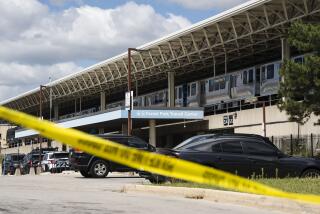Residents Say Homeless Concentrate Near Train Tracks : Transients: Two men shot inside a Canoga Park home apparently had lived in an encampment nearby. They were upset after a cleanup by homeowners disturbed their belongings, police say.
- Share via
Rod Van-Zeller wasn’t shocked to hear that the two transients shot Sunday after breaking into a house had been living along nearby railroad tracks.
Van-Zeller, whose Canoga Park auto repair shop sits next to the Southern Pacific tracks, said he sees more transients than trains.
A vacant hardware store that had once been a train depot, in fact, has become something of a hotel for transients who cut through chain-link fences and break windows to gain access to the structure.
“One time, I think we counted 20 guys going in there,” Van-Zeller said.
The shooting in the 6500 block of Keokuk Avenue--in which one man was killed and the other was seriously wounded--and the “homeless hotel” in Canoga Park are indications that perhaps thousands of homeless people take refuge daily along the isolated and seldom-patrolled tracks that traverse the county.
For years, responsibility for the tracks, and the transients who gather there, was primarily that of railroad companies who owned the right of ways.
But that responsibility has gradually shifted in recent years to the county transportation agencies who are purchasing right of ways to expand the region’s new mass transit system.
The Metropolitan Transportation Authority and the Southern California Regional Rail Authority currently own 215 miles of right of way in Los Angeles County--138 miles of which are used for the Metrolink commuter service.
Since the Metrolink service began in October, 1992, Los Angeles County sheriff’s deputies, hired to patrol the right of ways, have arrested 819 adults and issued citations to 380 juveniles for trespassing on the tracks, said Lt. Mike Glugman.
A significant number of the adult arrests were transients who live along the tracks, he said. “Encampments are springing up constantly,” he said.
MTA spokeswoman Roberta Tinajero said the agency and the regional rail authority that operates Metrolink spend nearly $500,000 annually to keep the tracks clean of trash and weeds.
“Those are the measures we have to keep the tracks from becoming homeless camps,” she said. “In light of our recent budget deficit, we are doing what we can do.”
Homeless advocates say transients take refuge on right of ways because there is a severe shortage of homeless shelters in Los Angeles County, and they refute charges that transients are responsible for crime in nearby neighborhoods.
“Homeless people are easy targets to blame because they are most visible,” said Bob Erlenbusch, executive director of the nonprofit Los Angeles Coalition to End Homelessness.
Erlenbusch said the homeless live along the right of ways, under bridges and in riverbeds because such sites provide privacy and shelter.
But property owners along railroad right of ways say the tracks are not a place for setting up private shelters.
Al Denney, leader of the South Winnetka Neighborhood Watch Group, said he has been complaining about transients along the tracks for more than a year but has received little response from transportation agencies that own the tracks.
Denney and other neighbors took it upon themselves Saturday to clear the right of way of brush, sleeping bags, clothes and food.
But when the two transients returned to their hovel Sunday, they were apparently upset that their few belongings had been disturbed.
In search of their possessions, the men entered the nearby home of Raymond John Komoorian, police said. Komoorian shot them with a .45-caliber pistol when he found them in his bedroom, police said.
One man, Jose Aleman Menjivar, 47, was killed. The second, identified as Ismael Rodriguez, 42, remains hospitalized in serious condition with bullet wounds to the chest.
Van-Zeller and other property owners along tracks in Canoga Park said there are rarely violent encounters with transients. Mostly, they leave trash. Occasionally, they commit petty crimes, such as stealing car batteries, the property owners said.
In a tour of the vacant hardware store in Canoga Park, Van-Zeller and fellow business owner Bob Bartels pointed out trash, broken bottles and strewn blankets that gave evidence to the regular occupancy of the building.
While touring the inside of the building, Van-Zeller and Bartels came upon Miguel Perez, a homeless man who had arranged a makeshift bed along the building wall with carpet padding and blankets. Nearby, he had several buckets of water, which he said he uses to wash himself and clean the food he finds in nearby dumpsters.
More to Read
Sign up for Essential California
The most important California stories and recommendations in your inbox every morning.
You may occasionally receive promotional content from the Los Angeles Times.











